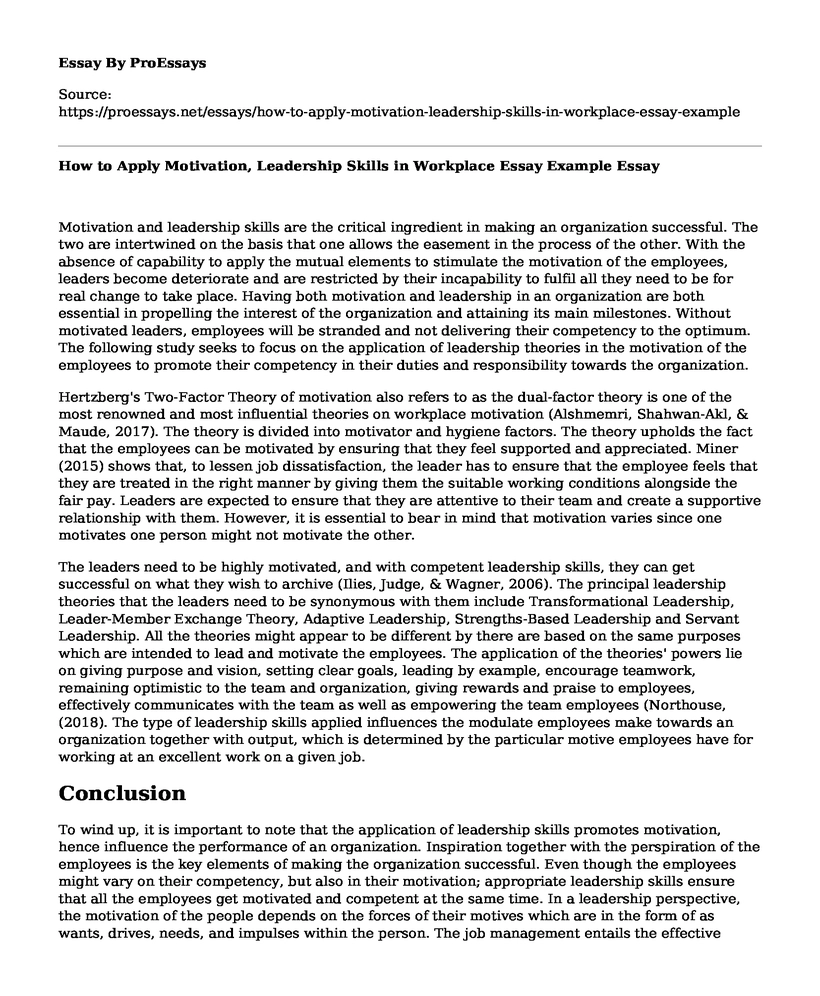Motivation and leadership skills are the critical ingredient in making an organization successful. The two are intertwined on the basis that one allows the easement in the process of the other. With the absence of capability to apply the mutual elements to stimulate the motivation of the employees, leaders become deteriorate and are restricted by their incapability to fulfil all they need to be for real change to take place. Having both motivation and leadership in an organization are both essential in propelling the interest of the organization and attaining its main milestones. Without motivated leaders, employees will be stranded and not delivering their competency to the optimum. The following study seeks to focus on the application of leadership theories in the motivation of the employees to promote their competency in their duties and responsibility towards the organization.
Hertzberg's Two-Factor Theory of motivation also refers to as the dual-factor theory is one of the most renowned and most influential theories on workplace motivation (Alshmemri, Shahwan-Akl, & Maude, 2017). The theory is divided into motivator and hygiene factors. The theory upholds the fact that the employees can be motivated by ensuring that they feel supported and appreciated. Miner (2015) shows that, to lessen job dissatisfaction, the leader has to ensure that the employee feels that they are treated in the right manner by giving them the suitable working conditions alongside the fair pay. Leaders are expected to ensure that they are attentive to their team and create a supportive relationship with them. However, it is essential to bear in mind that motivation varies since one motivates one person might not motivate the other.
The leaders need to be highly motivated, and with competent leadership skills, they can get successful on what they wish to archive (Ilies, Judge, & Wagner, 2006). The principal leadership theories that the leaders need to be synonymous with them include Transformational Leadership, Leader-Member Exchange Theory, Adaptive Leadership, Strengths-Based Leadership and Servant Leadership. All the theories might appear to be different by there are based on the same purposes which are intended to lead and motivate the employees. The application of the theories' powers lie on giving purpose and vision, setting clear goals, leading by example, encourage teamwork, remaining optimistic to the team and organization, giving rewards and praise to employees, effectively communicates with the team as well as empowering the team employees (Northouse, (2018). The type of leadership skills applied influences the modulate employees make towards an organization together with output, which is determined by the particular motive employees have for working at an excellent work on a given job.
Conclusion
To wind up, it is important to note that the application of leadership skills promotes motivation, hence influence the performance of an organization. Inspiration together with the perspiration of the employees is the key elements of making the organization successful. Even though the employees might vary on their competency, but also in their motivation; appropriate leadership skills ensure that all the employees get motivated and competent at the same time. In a leadership perspective, the motivation of the people depends on the forces of their motives which are in the form of as wants, drives, needs, and impulses within the person. The job management entails the effective channelling of employee motives along organizational goals through the application of practical leadership skills.
References
Alshmemri, M., Shahwan-Akl, L., & Maude, P. (2017). Herzberg's two-factor theory. Life Science Journal, 14(5), 12-16.
Ilies, R., Judge, T., & Wagner, D. (2006). Making Sense of Motivational Leadership: The Trail from Transformational Leaders to Motivated Followers. Journal Of Leadership & Organizational Studies, 13(1), 1-22. doi: 10.1177/10717919070130010301
Miner, J. B. (2015). Organizational behavior 1: Essential theories of motivation and leadership. Routledge.
Northouse, P. G. (2018). Leadership: Theory and practice. Sage publications.
Cite this page
How to Apply Motivation, Leadership Skills in Workplace Essay Example. (2022, Dec 04). Retrieved from https://proessays.net/essays/how-to-apply-motivation-leadership-skills-in-workplace-essay-example
If you are the original author of this essay and no longer wish to have it published on the ProEssays website, please click below to request its removal:
- Essay on Evaluation of Learning and Development
- The Role of an Organization's Treasury Department in Mitigating Organizational Risk
- Letters About Business Problems With Employees
- Response Paper on Data Security
- Trigger Event in a Business Paper Example
- Leadership Styles: Psychometric Survey & Harvard Business Review - Essay Sample
- Scientist Practitioner Model - Free Paper Sample







